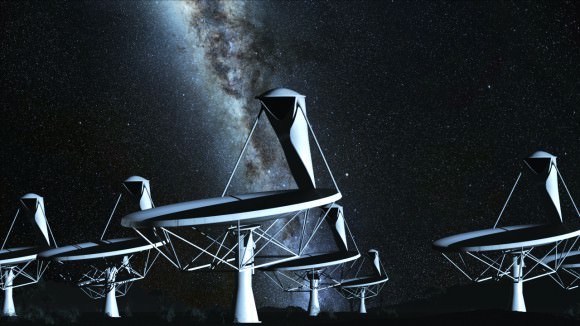In an anticipated great compromise, South Africa and Australia will share their sites for the Square Kilometre Array telescope, the world’s largest and most sensitive radio telescope. Both sites were competing to win the $2 billion contract for the SKA, which is hoped shed light on how the Universe began, why it is expanding and whether there is any other life beyond our planet.
“We have decided on a dual site approach,” said SKA board chairman John Womersley, following a meeting of the SKA organisation’s members. “This position was reached after very careful consideration of information gathered from extensive investigations at both candidate sites.”
An SKA press release said the majority of the members were in favor of a dual-site implementation model for SKA. The members noted the report from the SKA Site Advisory Committee that both sites were well suited to hosting the SKA and that the report provided justification for the relative advantages and disadvantages of both locations, but that they identified Southern Africa as the preferred site. The members also received advice from the working group set up to look at dual site options.
Therefore, the majority of SKA dishes in Phase 1 will be built in South Africa, combined withMeerKAT, a seven-dish prototype interferometer array built by South Africa, where 190 dishes will be added. 60 dishes will be added to the Australian Square Kilometre Array Pathfinder(ASKAP) array in Australia, as well as a large number of omni-directional dipole antennas. This will give the Australian site a wide-field survey capability, whereas South Africa will be able to look deeply into a narrow part of the sky.
Three antenna types, high frequency dishes and mid and low frequency aperture arrays, will be used by the SKA to provide continuous frequency coverage from 70 MHz to 10 GHz. Combining the signals from all the antennas will create a telescope with a collecting area equivalent to a dish with an area of about one square kilometer.
All the dishes and the mid frequency aperture arrays for Phase II of the SKA will be built in Southern Africa while the low frequency aperture array antennas for Phase I and II will be built in Australia.
“It’s a distinct possibility that we’ll discover a new type of astronomical object,” CSIRO SKA Director Brian Boyle told Universe Today in interview earlier this year. “History has shown that every time we’ve gone to a new astronomical wavelength domain, we pick up new objects.” An example of that is the discovery of pulsars in radio
At the lowest frequencies, the SKA will be looking for red-shifted hydrogen, looking at the very earliest events of our Universe. At highest frequencies will look for things like pulsars or even pre-biotic molecules in space. The array will also be very effective in looking for transient events like supernovae or gamma ray bursts.
“The placement of the array will give it a phenomenally wide field of view, between 30 and 100 square degrees,” Boyle said. “It is hoped to provide the first all-sky survey at phenomenal depths at these wavelengths, which can then be compared with other all-sky surveys done at optical wavelengths.”
One downside of splitting the frequencies between the two sites is that some of the science may suffer. One of the original science requirements of the SKA was to look at the same piece of the sky at the same time in different frequencies. Boyle said there is not much common sky between the two locations.
Another is cost for having redundant computing and networking capabilities, not cheap for the remote areas where both sites are located.
But the dual-site approach solves political issues, and the SKA press release says the arrangement “will deliver more science and will maximize on investments already made by both Australia and South Africa.”
Womersley said that in this approach “Science is the winner,” and by building on existing pilot projects in both countries, the SKA will be made even more powerful.
Additionally, technology is sure to get a boost, as the SKA project will drive technology development in antennas, data transport, software and computing, and power.
Additionally, the SKA members say the influence of the SKA project extends beyond radio astronomy.
“The design, construction and operation of the SKA have the potential to impact skills development, employment and economic growth in science, engineering and associated industries, not only in the host countries but in all partner countries,” said their press release.
Source: Universe Today

No hay comentarios:
Publicar un comentario